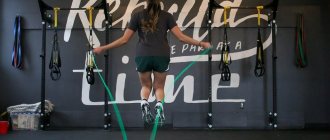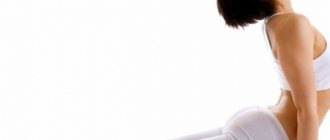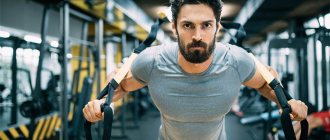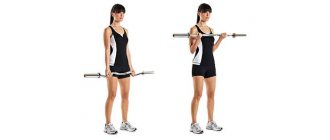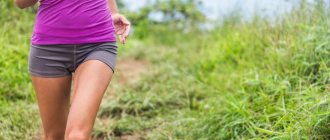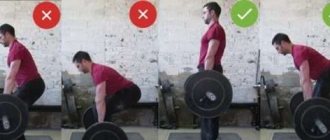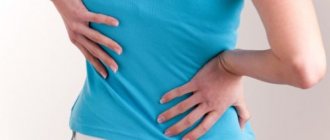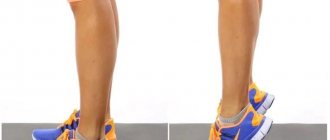Possible reasons why weight may have increased after training
Before we start analyzing weight gain, let's make an important point. In the process of losing weight, there cannot be constant weight loss. From time to time the weight will stop for a couple of weeks (or even a month!) and even increase - and this is absolutely normal. Even if you do everything correctly and competently, your weight will not melt before your eyes.
When losing weight, the body gradually and rather slowly adapts to new conditions. Give it time to change biochemical processes and stabilize weight.
Muscle swelling
The most likely cause of weight gain after exercise is muscle swelling. After unusual loads, water begins to be retained in the muscles, and they increase in volume. This phenomenon is temporary and has nothing to do with muscle growth. In just a couple of weeks they will return to normal, and your weight will go down.
What to do about it?
Doing nothing, this is a natural process in the body, there is no escape from it. Wait 2-3 weeks, the muscles will adapt to the load and the weight will go down. The main thing here is not to be afraid of the numbers and to systematically continue training, not paying attention to the scales. Also, do not forget to do a good stretch after exercise: high-quality stretching workouts perfectly tone your muscles and help create a beautiful relief.
Exceeding daily caloric intake
Don’t think that if you play sports, you can eat in unlimited quantities. This is wrong. An average workout can help you burn between 300 and 500 calories in an hour, and that's just a slice of your favorite layer cake. If you eat more than your body can absorb, then not only will you not lose weight, but you will also gain weight after training.
What to do about it?
Stick to a moderate diet, or better yet, start counting calories. Successful weight loss is 80% a well-established diet and only 20% regular exercise. Keep a food diary, count calories, avoid sweets and fast food. Sports will not lead you to an ideal body if you do not change your eating habits. Alas, this is true.
Popular misconception why weight may increase after exercise
Many people believe that weight gain after exercise is a consequence of muscle growth. If we are not talking about strength training with heavy weights and protein nutrition, then this is an absolute misconception! Even if you really want to, it is very difficult for girls to build up muscles: the gain in muscle mass per month, at best, will be no more than 500 g. With regular training, there will be no muscle growth, so there is no need to worry about it. At the most, you will tone them up and make your body more toned and sculpted.
Four important tips to make your workouts effective:
- don't step on the scale every day and don't panic about the numbers
- control your diet
- do a good stretch after your workout
- don’t be afraid to exercise: even if the weight increases the first time after training, your body will be closer to its ideal shape
- measure volumes and look at changes in body quality by taking photographs.
What to do if your muscles are swollen and painful: treatment plan
Muscle swelling after strength training is a fairly common phenomenon.
The reason may not only be in the training itself - sometimes it is a signal from the body about problems. In what cases is swelling normal, and when is a doctor’s help needed? What to do to remove swelling? There are several reasons why muscles may swell after exercise. They can be divided into two groups: disease-related and non-disease-related.
In this case, the swelling will differ:
- for reasons not related to internal diseases, spasm and swelling of the muscles are characteristic, hard to the touch, as if in constant tension;
- a sign of the disease will be the accumulation of fluid in the intercellular space - in this case, the muscles feel soft to the touch.
Sometimes, as a result of stress, illness or physical activity, cells produce a lot of waste products, which are protein compounds. There is so much waste that the lymph does not have time to remove it. They accumulate in cells, causing them to increase in size and lose their elasticity. The tissue becomes very dense, and lymph can no longer flow between the cells. This is how edema forms - an accumulation of cells overflowing with waste.
There are several situations that can lead to the development of swelling after exercise:
- Active workout with a usually sluggish lifestyle. For example, if, after sedentary work during the day, you take on a heavy load in the evening, an imbalance appears in the tissues. Therefore, if life in general is not particularly active, you should not try to make up for everything you missed in the gym. It is better to start with a moderate load, alternating it with sufficient rest.
- Exercising after wearing tight shoes or clothing. Sometimes there are streaks on the skin from tight clothing, and your feet are in tight shoes all day. Such compression disrupts the normal flow of lymph and leads to swelling, especially if, after removing the compressive element, you immediately apply a load.
- Microtears of muscles. This is especially common for bodybuilders. Under load, the microfibers in the muscle break, then it grows together, becoming stronger and larger in volume. This also explains muscle pain after exercise. Any tissue damage is accompanied by inflammation, and inflammation is accompanied by swelling.
- Serious disruption to normal lifestyle. Serious trouble, great joy or excessive stress throughout the day can lead to disruption of lymph flow.
- Too much liquid. Drinking too much water during exercise can cause swelling.
In some cases, edema is the result of pathological processes in the body. Diseases may not make themselves felt until physical activity. Training in this case will serve more as a detonator.
The most common diseases that cause swelling after exercise:
- Injuries. If the load is improperly distributed, some joints and muscles can be damaged. Sometimes a person, being heated and on an emotional high, does not immediately notice the injury.
- Vein disease. To do this, it is not necessary to have external varicose veins, which are visible to the naked eye: deep vein thrombosis is even more dangerous, but has a less clear clinical picture. Most often with this disease, the legs swell.
- Impaired renal excretory function. Sometimes the kidneys cannot cope even with the normal volume of water required during training. Swelling appears not only on the legs, but also on the arms, sometimes on the face.
First of all, you need to determine the cause of the swelling. Sometimes you need to give the body the necessary rest - this applies to those who, after a hard day, gave the body a serious load in the gym. However, you should not completely abandon subsequent training, as this may only increase swelling.
In some cases, swelling does not go away on its own. Massage has a good effect - a direct mechanical effect on the muscles. Improves lymph flow and blood circulation. To feel the results of a massage, it is better to go to a specialist. A good effect can be obtained if you combine massage with warming gels and ointments, for example, Fastum gel.
Experienced athletes recommend getting rid of swelling after training using the following scheme:
- Trituration.
- A hot shower, in which you need to direct a stream of water to the swollen area.
- Deep massage (if necessary, through pain) and rubbing with warming ointment.
If swelling is accompanied by severe pain, the doctor may recommend taking non-steroidal anti-inflammatory drugs (for example, Nimesulide).
To get rid of swelling that appears after an injury, you need to apply cold to the muscle.
If the cause of edema is venous insufficiency, you need to consult a doctor who will prescribe ventonics and angioprotectors (Troxevasin, etc.). It is also useful to regularly massage the swollen part of the body. If your legs are swollen after a workout, we recommend reading an article on how to properly massage swollen legs.
If kidney function is impaired, heart disease or nervous system disease occurs, you need to find out what exactly is wrong with them, and only then begin treatment.
Before starting classes, you should make sure that there are no contraindications to this type of training. If there are no concomitant diseases or occur in a safe form, simple preventive measures will help to avoid edema.
They can be divided into three categories: what you need to do before exercise, during exercise and after exercise.
Before training
It is important to fully rest and get enough sleep. You should not burden the body during viral respiratory diseases. It is better to change tight clothes and tight shoes to looser ones a few hours before training.
Before starting exercises, you need to warm up your muscles. This includes several stages: first a shower, then self-massage and application of warming ointments. This will increase blood flow and prepare cells for stress and cleansing.
The next stage is aerobic warming up. You can run or walk at a moderate pace, pedal without load. This will improve blood circulation in the deep veins and smallest capillaries. The body will tune in to physical activity.
The third stage is warming up the joints and stretching. The set of exercises will depend on the expected load. There is no need to rush while stretching - this can lead to injury.
During training
You need to perform the exercises following the instructions of the trainer. If there is a tendency to painful swelling, you need to reduce the intensity: the load should be optimal, not maximum. This is similar to eating: if you eat in small portions, there will be a feeling of slight hunger, and if you overeat, there will be heaviness and indigestion, the next meal will be unpleasant.
You should not drink too much water during exercise.
Completing the workout is important. If you stop abruptly, the removal of decay products will be disrupted, since all processes that accelerated during exercise will slow down. To avoid this, you need to devote the last 10-15 minutes to gradually reducing the intensity of the exercises.
After classes
You need to perform a set of stretching exercises. It differs from those that need to be done before training: now the goal is not to tone the muscles, but to relax them. Therefore, you need to pull them not to the point of pain, but until the moment of relaxation. The ideal ending is a combination of scratching and breathing exercises.
Showering after a workout is equally important. You need to go over all the muscles with the jet, especially warming up the collar area - it is responsible for relaxing the whole body. A contrast shower will help you relax and refresh at the same time. All this will protect you from swelling.
Swelling after exercise is a common occurrence, which in some cases may indicate pathology. You should carefully monitor your health, choose the optimal load and pay due attention to warming up and stretching before and after exercise.
source
Traditionally, people associate swelling on the body with the accumulation of excess fluid in the body, but swelling in muscle tissue has a different nature. Tumors and pain in the muscles are caused by the accumulation of protein compounds produced by the hormonal system. To the touch, such swelling is similar to compaction, which causes pain when moving.
This inflammatory process can begin as a result of the accumulation of waste products from muscle cells. During illness, stress and other factors, protein compounds accumulate in the blood. In order to reduce their concentration in the circulatory system, the body transfers excess to muscle tissue.
When lymph does not have time to remove all protein compounds, they accumulate and take up more and more space. The cells grow and press on each other, causing muscle pain. Swelling in the muscles of the lower extremities, chest, back or arms does not go away on its own. If treatment is not started, swelling can gradually lead to serious complications:
- numbness of the limbs;
- hypertension;
- osteochondrosis;
- colitis;
- dysplasia;
- development of malignant tumors.
Inexperienced athletes sometimes wonder why muscles swell after training? The main reason is the accumulation of lymphatic fluid in the muscle tissue. This happens for the following reasons:
- high loads in the gym with a sedentary lifestyle (for example, people with sedentary work);
- starting training after removing tight shoes that impeded blood flow (for this reason, mainly the calf muscles and sometimes the thighs swell);
- the habit of sitting with your legs crossed (this leads to swelling of the leg muscles).
If muscle swelling is caused by training loads, the swelling will go away on its own within a few hours.
When the muscles of the legs, arms, neck, back or other parts of the body hurt and swell, the treatment regimen is approximately the same in all cases. The doctor determines the causes of pain and the factors that provoked the disorder, and then draws up a complex of therapy.
After classes
- massage and rubbing of muscles with warming gels and ointments;
- manual therapy aimed at stimulating local blood circulation;
- physiotherapeutic procedures to relieve inflammation;
- physiotherapy;
- acupuncture.
- getting injured while pumping the quadriceps muscle in training;
- tendon damage (this occurs more often in older people);
- problems with blood supply to the thighs;
- joint diseases.
- intoxication of the body;
- drug and alcohol addiction;
- stress;
- parasitic diseases;
- infectious and viral diseases;
- autoimmune disorders;
- injuries during physical activity.
- Pain in the navel area: causes and treatment
- How to calculate your ideal weight
After classes
Questions and answers why weight increases after exercise
1. I started exercising regularly to lose weight, but after 3 weeks the weight did not decrease at all. Does this mean I'm not losing weight?
During physical activity, muscles retain water, so the weight may increase or stay the same as a result of training, while the fat layer will disappear. Try to measure volumes and look at changes in body quality (take photographs), this is a much more visual way to monitor the process of losing weight.
2. I've been training for a month now, but the weight is increasing. I measure the volumes, look at the “before and after” photos - almost no changes. What could be wrong?
To lose weight, it’s not enough to just exercise; you need to watch your diet. As we already said, 80% of success in losing weight depends on nutrition. Exercise helps to tighten the body, improve its tone, get rid of sagging, but the process of losing weight and getting rid of excess fat is possible only with a calorie deficit. If you are not losing weight (regardless of whether you exercise or not), then you need to reconsider your diet.
3. I try to eat right and exercise for a long time, but the weight does not decrease. Why?
The main law of weight loss: eat less than the body is able to expend energy during the day, so that fat reserves begin to be consumed. All diets or nutrition systems are based on this. One of the most convenient and effective methods of controlling food for weight loss is counting calories. In this case, you will not be limited in the range of products and will be able to plan your menu yourself during the day: the main thing is to keep within the given numbers, i.e. eat in a calorie deficit.
Just because you're eating healthy doesn't mean you're eating in a calorie deficit. Even with healthy products, you can go over your acceptable limit. In addition, very often during sports activity the appetite increases, thus the body tries to replenish the energy spent. Therefore, you may, without noticing it, start eating more: snacking more often, eating larger portions, choosing higher-calorie foods. Without control and clear numbers, we cannot always correctly formulate a menu for weight loss.
Why do muscles hurt?
Painful sensations arise due to the fact that muscle structures are destroyed as a result of intense training. This leads to a displacement of myofibrils, in which the lactate concentration sharply increases.
Pain of an infectious, inflammatory or traumatic nature cannot be ignored! Those who risk repeating the power load can seriously injure their muscles. And treatment takes more than one month.
Soreness appears after the first workouts or after a long pause; with regular exercise, the pain disappears. This does not mean that you are doing the exercises incorrectly, just that your muscles are getting used to the load.
What does it look like? Discomfort occurs already in the first hours after exercise; after 24 hours, mild pain occurs; on the third day, pain in the muscles reaches its peak. This is expressed by acute pain, burning, muscles have difficulty contracting and stretching. On days 4-5, the painful syndrome decreases; if this does not happen, you should visit a doctor.
Muscle pain after first exercise
As for moderate post-workout pain, it occurs for the following reasons:
Muscle pain after prolonged exercise
Exhausting physical activity exacerbates the sensitivity of nerve endings, which occurs due to an imbalance of fluid and salt in the body. This can cause muscle cramps in the lower leg.
Severe pain, weakness, loss of strength occurs due to overtraining. This condition is typical for athletes of any level whose muscles do not have time to recover.
Full training with unhealed microcracks is considered very harmful. Such activities deplete the body, weaken the immune system, and provoke inflammation of the joints. Due to an imbalance in nitrogen balance, the secretion of hormones decreases, joints and tendons become fragile, and the risk of injury increases. Regular overtraining is extremely dangerous for the immune and reproductive systems
, as it leads to hormonal imbalances, disruptions in the menstrual cycle and infertility.
Symptoms: phantom pain two hours after exercise, which appears and disappears. In such cases, it is recommended to reduce physical activity or stop exercising altogether for 15-20 days.
Injured muscles and joints cause aching or sharp, paroxysmal and stifling pain, which becomes stronger with sudden movement or even slight load. The injured area swells and manifests itself as subcutaneous hemorrhage, and the general condition worsens. Pain appears immediately or within 24 hours.
A joint that clicks or crunches is a sign of injury.
Swelling of the legs
Edema is considered to be a consequence of the accumulation of lymphatic fluid in various parts of the body. Edema is considered the result of an imbalance in the body's tissues and venous vessels, from which excess fluid is released.
Edema is often caused by various types of diseases. Sometimes it happens that a person is healthy, but swelling is present. Swelling often appears after active sports. It is not clear why my legs swell after exercise.
Often the location of edema can tell about the cause of the lesion. Accurate information on the occurrence and further control is provided by a competent doctor.
Tumor in the pectoral muscles
One common cause of swelling, swelling and tenderness in the pectoral muscles is myositis. The symptoms gradually increase, but it is important to prevent the disorder from worsening. In acute periods, the pain radiates to the arms and neck, and upon palpation, tension in the pectoral muscles is felt. Myositis, which causes swelling and pain in this area, can be identified by the following signs:
- pain on the surface of the chest muscles;
- swelling and swelling;
- increase in local temperature;
- feeling of pain when swallowing;
- skin redness;
- shortness of breath and cough;
- headaches.
The pecs may also swell if an athlete has pulled a muscle or suffered another injury.
Tumors that can be found on muscles are of a different nature - benign and malignant. Benign ones include leiomyoma and rhabdomyoma.
Leiomyoma is localized on smooth muscle, regardless of age. If treatment is not taken, the tumor can turn malignant. The swelling develops slowly and manifests itself as ulcers on the surface of the skin. Rhabdomyoma is localized primarily on the transversely striated muscles of the chest, back, arms and legs, as well as in the neck.
Malignant muscle tumors are dangerous, so they cannot be avoided without medical help. One of the varieties is rhabdomyosarcoma, which develops similarly to rhabdomyoma, but is of a low-quality nature. Most often, pathologies develop in the thighs and calf muscles of adults.
Less common is malignant leiomyosarcoma, which affects smooth muscle, mainly in women. Localized on the trunk and lower extremities, accompanied by ulcers on the surface of the skin. One of the most dangerous muscle tumors is osteoclastoma, which requires urgent surgical intervention.
Be attentive to your body and do not allow tumors to develop. If your muscles swell frequently, be sure to see a doctor and get a diagnostic test to avoid serious health problems in the future.
Share "? Causes of muscle swelling, why muscles swell after exercise, is muscle swelling dangerous?
https://www.youtube.com/watch?v=GaU4je77tcQ
source
source
source
source
source
Share “Causes of muscle swelling, why muscles swell after exercise, is muscle swelling dangerous”
source
source
Causes not related to disease
It is often possible to notice leg swelling after a strenuous workout, but it is not the actual exercise that causes fluid accumulation. The reasons should be sought in something completely different.
The main causes of swelling after exercise:
- Edema is often caused by an inactive lifestyle during the day. Large physical loads over a long period of time will provoke the occurrence of a disorder. If your usual lifestyle is not active and has a sufficient amount of movement, it is preferable to create moderate physical activity. Remember, after physical activity when playing any sport, you should give your body sufficient rest.
- The cause is wearing narrow high-heeled shoes during the day. Why the violation occurs is easy to explain. With narrow, tight shoes, individual leg muscles are not used, and the body does not have the ability to organize normal outflow of blood and fluid.
- Women have a known bad habit that interferes with the normal outflow of blood. Now we are talking about the habit of sitting with legs crossed. This position often causes swelling of the legs.
- Sometimes the cause is simple fatigue after a busy day. To combat such swelling, you just need to organize regular rest of your legs, especially after active physical activity.
Pain and swelling of the thighs
Pain requires closer attention and is most likely pathological in nature if:
- It is strong or constant, localized in the joints and is accompanied by a crunching or clicking sound. Especially if your legs don’t obey you or you can’t even walk;
- Tissue damage is visible to the naked eye - after training, bruises appeared on the legs, swelling, swelling;
- Over time, the pain only intensifies and does not go away within 5-7 days.
In such situations, you should consult a doctor.
In other variations, your pain is most likely the usual post-workout muscle fatigue, accompanied by the accumulation of lactic acid in the muscles and called sore throat. Such things disappear within 2-3 days. As a rule, the body recovers by the next workout, and muscle pain of this nature is barely noticeable.
It is impossible to completely eliminate cramp pain, but it is possible to reduce it by resorting to proven means:
- Don't forget about a good stretch at the end of the session;
- After finishing the workout, take a very warm or hot shower, using a stream of water, as if massaging the muscles, and at the end of the water procedure, rub with a mild warming ointment;
- The next day, give the same muscles a small load or walk from work - such a walk will warm up all the muscles of the body and help remove lactic acid from the muscle fibers;
- Pay attention to a balanced and nutritious diet.
Painful sensations typical for playing sports are often also the result of regularly repeated mistakes:
- Technically incorrect execution of the exercise, which leads to incorrect distribution of the load and gives negative sensations instead of the expected result;
- Exhaustion of strength when choosing an excessive pace of training.
In the first case, you must make sure that the exercises are performed correctly - practice in front of a mirror or with an instructor, feel the muscles in action and remember the correct execution of the exercise. You can only increase the intensity or strength load if you are confident in the correct technique.
But pain is not the only negative sensation that can be present in our lower extremities after exercise. What else and how do our feet signal us?
Common diseases
Often a person develops a disease that causes edema. Sometimes a woman is not aware of the presence of the disease, mistakenly associating the appearance of edema with attending a workout.
Edema is a consequence of diseases:
- Impaired blood flow through deep blood vessels;
- Presence of joint diseases;
- Diseases that prevent blood from flowing to the heart in the required amount.
- Excess weight promotes the release of lymph fluid into the tissue, and edema is more likely to occur.
Prevention of sprains
To prevent stretching of the biceps of the arm, as well as all other muscles, a special warm-up warm-up should be carried out before physical activity. It is necessary to dose physical activity and regularly perform exercises aimed at strengthening muscles. Any increase in load must be carried out in stages.
Nowadays it has become fashionable to lead a healthy lifestyle. Therefore, many men and women begin to eat right and also exercise to the best of their ability. However, without practical experience, it suddenly turns out that many nuances remain unclear. For example, the question of what to do if your arms hurt after training worries many beginners, and not only athletes. Let's look at the question together and finally give an answer to what is happening to our body and why such negative moments can be observed.
Treatment
Before treatment, determine the actual cause of their appearance. A good doctor will help you cope with the task.
The hospital will most likely conduct a full examination, gradually eliminating diseases that can cause fluid accumulation. After a complete examination, the doctor will make an informed decision and prescribe effective treatment.
The doctor will prescribe special medications that reduce blood viscosity. Taking the medication will increase the rate of outflow in the venous vessels.
Sometimes diuretics are prescribed, which will help remove excess fluid from the body in a short period of time.
Universal training tips
When planning to improve your physical fitness by starting exercises and training, it is better not to take them lightly. Most often, with correctly calculated loads, it is possible to achieve your goals quite quickly. If you can’t make the right plan yourself, you can turn to a professional trainer. For a beginner, this is simply a must, so as not to end up with the problems described above.
There are a number of simple tips that you can follow when working out in the gym or at home. This will protect you from risks and give you a chance to quickly achieve results.
Graduality is the key to success
Only by slowly increasing the load can you go all the way from start to finish without problems. On the third day, you shouldn’t strive to do everything like the pumped-up men who have been visiting this place for many years. Start small, otherwise health problems cannot be avoided.
Good warm-up and cool-down
Any workout begins with a good warm-up and ends with a cool-down; this is an immutable law. Only with this approach will you avoid injuries to muscles, ligaments and joints. At the same time, make sure that your warm-ups work exactly the muscles that you will train. Stretching exercises or light jogging are ideal as a cool-down.
Technology is everything to us
Never start an exercise unless you know exactly how to do it. Especially when it comes to complex exercise equipment that you don’t fully understand. Mistakes and missteps can do more than just cause you to fail to make progress. You can get seriously injured, from which you will have to recover for a long time.
Drink plenty of fluids
If you drink little, especially when doing workouts, your blood will become somewhat thicker. This creates additional stress on the heart and blood vessels. Therefore, you need to drink as much as your body requires. There is a lot of material on how and when to drink water during training, which would not hurt to read separately.
Water treatments
If we carefully consider almost all the problems that we have discussed, an interesting fact emerges. A swimming pool and a contrast shower are great for solving almost all of them. It wouldn’t hurt to carry out water procedures of this kind regularly, as they have a general healing effect.
Proper nutrition
Don't forget that the diet should be balanced. This is especially true for those who train hard. If the body does not receive enough of the vitamins and minerals it needs, then it will be much more difficult for the muscles to bear the load. Moreover, improperly organized nutrition can lead to serious complications and the development of diseases.
Relaxing massage
If during training you have any problems with your hands (increased sensitivity, pain, swelling, etc.), a relaxing massage will help. But even those who are fine and have no unpleasant symptoms should pay attention to it. It benefits both professional athletes and green beginners in the gym.
Pain relief with medications
In the most extreme case, when there is no strength to endure the pain, many use painkillers. However, this can only be done according to a doctor’s indications and nothing else. Thoughtless, uncontrolled absorption of medications that you “prescribed” for yourself leads to disastrous consequences. Although for mild symptoms it is quite acceptable to use soothing, relaxing or cooling creams and ointments.
What you can do yourself
It is possible to relieve the unpleasant and painful sensations of swelling on your own:
- Try to raise your legs above heart level more often. Spend at least an hour in a position with your legs raised.
- After swelling caused by attending a workout, you should ensure maximum rest. Lie down for a long time.
- After consulting with your doctor, you can take anti-inflammatory drugs. The products relieve pain and partially swelling.
- Try not to sit or stand for a long time.
- It is permissible to wear special compression garments. Nowadays pharmacies offer a wide range of stockings and tights.
- Try to adjust the menu, reduce the use of salt as much as possible. Do not get carried away with flour products and sweets. If possible, you should eat boiled or baked food.
Causes of biceps strain
One of the causes of muscle injury is tissue overstrain due to sudden movement. So, for example, a strain in the biceps of the arm can occur during improper stretching of the muscle or as a result of its sharp contraction due to the effort that has to be applied to perform an exercise or other physical activity.
A distinction is made between complete and partial muscle rupture, also called an arm muscle strain. The degree of injury is determined by the strength of muscle contractions and the size of the load. The entire muscle or just a few of its fibers may rupture. The most common injury is mild sprains; they can occur both in people who are intensely involved in sports and in people who neglect physical education.
Folk remedies
Without the help of doctors, in the distant past, women struggled with swelling of the legs. Over a long period of time, an abundance of effective recipes have been formed, after the use of which relief will come:
- Birch leaves were often used to combat swelling. They filled canvas bags with them and placed the legs there. For three to four hours, my feet were actively sweating. Through a series of procedures, swelling will significantly decrease or disappear altogether.
- A freshly prepared infusion of berries and elderberry bark will help in the fight.
- Compresses made from wax, olives and oil give a good effect. A homogeneous composition is wrapped around problem areas on the body.
- A garlic mask will help reduce swelling. To prepare the composition, you will need to chop the head of garlic, pour boiling water and leave for 40 minutes. The cooled mixture is rubbed into problem areas. After half an hour, wash your feet with cool water.
- Ice, which should be regularly rubbed on your feet in areas of swelling, will help relieve discomfort.
- Foot baths are made. Add 2 tbsp per liter of water. l. sea salt. During the water procedure, it won’t hurt to give a light massage to problem areas.
People prone to swelling of the feet should forget about using too hot water. Water procedures with hot water will cause dilation of venous vessels, causing an imbalance of lymph fluid. After training, it is better to take a cool shower.
Injuries during training
If the rules of the training process are violated, deep damage to muscle tissue can occur. In this case, particularly intense delayed muscle pain is observed, which deprives a person of working capacity, interferes with normal movement and lasts more than three to four days.
Such pain indicates the death of a large number of muscle fibers in a muscle overloaded during training. The consequences of overly intense training can be muscle necrosis and fibrosis, rhabdomyolysis, neuromyositis, tendovaginitis, tendonitis and other conditions. Treatment of these diseases is long and often requires immobilization. In some cases, muscle damage is irreversible and leads to the development of contracture.
Expert: Natalya Dolgopolova, general practitioner Author: Anastasia Anuchina
The material uses photographs belonging to shutterstock.com
Special gymnastics
To reduce swelling, special exercises are prescribed that will have a beneficial effect on the general condition of legs with frequent swelling.
Gymnastics includes exercises:
- Starting position – standing. In a relaxed state, lift your toes one at a time.
- Previous starting position. It is worth raising yourself on your toes and remaining in this position for at least 10-15 seconds.
- Starting position – standing on your toes. From the accepted position, perform low jumps.
- Sit as comfortably as possible and relax your legs. Alternately lower and raise your toes. Try to hold them at the top for a few moments.
The set of exercises is recommended to be carried out in two or three approaches. Do each exercise 10-15 times. You should not ignore simple exercises, even in the presence of regular physical activity, by attending a training session.
Treatment of edema will become extremely effective if you use the right combination of traditional medicine and folk remedies. Remember, treatment of edema is carried out only with the permission of a doctor. Practicing self-medication can sometimes harm your health, and uncontrolled use of medications will lead to disruption of the functioning of organs and systems of the body.
Methods for Reducing Muscle Pain
There are several ways to relieve or shorten the duration of muscle pain on your own. If the pain is of an acute traumatic nature, self-medication is prohibited, you must be examined by a doctor. Below are methods for reducing pain for each muscle group separately.
Actions for muscle pain in the legs
- Every athlete should have proper rest and sleep at least 7 hours a day. This will help the muscles recover and microcracks heal faster.
- You can relieve muscle spasms in the legs with a hot bath or shower; baths and saunas are also a great option. Thanks to warm water and steam, blood vessels relax and dilate, and local blood flow improves.
- Warm up the sore areas with a massage. This improves blood circulation and promotes the removal of lactate.
- Experienced athletes are advised to finish each workout. Try yoga or Pilates.
- As a last resort, if the pain is very severe, take a painkiller. But after this, immediately go to the hospital, as intense pain indicates an injury.
- Harness the healing power of cold. To do this, soak a towel in cold water or wrap an ice cube in it and apply it to the sore spot.
Actions for pain in the hands
You can relieve muscle pain with a simple rest, which is at least 48 hours after the last workout. You can rub the affected areas with a special anesthetic and anti-inflammatory ointment. It is recommended to spend 10 minutes stretching, this will bring long-awaited relief. You can take a bath with hot water or go to the sauna.
Back muscles hurt - what to do?
The back muscles hurt due to the fact that the load is not uniform, this happens after a sudden lifting of weight or incorrect technique for performing the exercise.
You can relieve pain using the McKenzie method:
- You need to lie on your stomach on a flat, hard surface.
- Lean on your elbows and begin to slowly rise, while bending your back as much as possible. Raise your head, look forward.
- Lean on your hands and smoothly lift your torso, while your pelvis lies on the floor. Stay in this position and return to the starting position.
- If pain is felt on the right or left, change the starting position. To do this, lie on your stomach, turn your hips in the direction opposite to the one that hurts and do the exercises.
Post-workout pain in the neck and shoulders
You can relieve pain from the collar area with a simple exercise that is performed while lying on the sofa.
Starting position: lying on your back. Press your chin to your chest, while the back of your head rests against the back of the sofa. Then move to the edge and gently hang your head. Shoulders rest on the sofa
. Slowly turn to the right side and freeze in this position for at least 25 seconds.
Perhaps everyone who has ever worked out at home or even at home is familiar with the discomfort and pain in the muscles the morning after exercise. Sometimes the pain goes away within a day, and sometimes it “lasts” for several days. Moreover, it has been noted that the greatest muscle discomfort is experienced by beginners, whose body is not yet accustomed to the load, as well as by athletes who simultaneously increase the load by more than 10%. Also, the cause of the so-called delayed pain after training can be neglect and a hitch.
Why weight may increase after exercise
Some people who live by the rules of a healthy diet, proper regimen and rest, play sports, visit gyms, and go to fitness classes. At first glance, a feeling of lightness appears, a sense of purpose is developed, but when it comes to weighing, it turns out that the weight does not go away, but rather, it comes on.
According to all the rules and laws, weight should go off after training, why do people experience the opposite effect?
Many representatives of the fair sex react painfully to such situations. Young people also encounter this, but here the situation is different: after all, for the most part, men visit gyms to gain muscle mass. Therefore, weight gain is not a reason for them to be upset. Women enroll in sports clubs for effective and quick weight loss, in other words, to reduce weight by expending energy during exercise. But the weight doesn’t want to come off.
Why can muscles hurt?
Sports doctors, coaches and experienced athletes still cannot come to a consensus on why muscles hurt after training. There are two most common theories, and each of them has its own arguments:
Interesting fact
Previously, athletes did not see the benefit of lactic acid, believing that it was because of it that they experienced pain. However, recent studies have shown that when lactate is “washed out” from muscles, the overall level of blood acidity increases, which has a rejuvenating effect on the body as a whole.
- Burning sensation in the muscles due to lactic acid (lactate). For a long time it was believed that post-workout pain is associated precisely with the release of shock doses of lactic acid during sets. It “burns” the muscle tissue and unpleasant sensations arise. However, it has now been proven that lactate levels drop significantly immediately after the end of exercise, so the burning sensation from it is observed only during training and half an hour to an hour after it.
- Delayed muscle pain due to microtraumas (ruptures, sprains). This type of pain occurs due to muscle overload - microwounds are formed in them, the healing process of which is felt in the form of painful manifestations. Naturally, the greater the load, the more injuries and the stronger and longer the pain syndrome will last. Moreover, even among professional athletes there is still an opinion that the intensity of muscle pain directly depends on the effectiveness of training: if a muscle hurts, it means it is growing. This is not entirely true; during training, muscles will be built up in any case, but a week of pain that does not allow you to bend your arms or walk normally will definitely not have a good effect on your sporting achievements.
Let's name the main reasons why many people gain weight after training:
Muscle swelling
A common reason why body weight increases after exercise. During the first month after intense exercise on the muscles, water accumulates in them. As a result, the muscles increase their volume, and the person gains weight. Sometimes people mistakenly associate this phenomenon with muscle growth. Due to the natural characteristics of physiology, it is difficult for women to gain even a kilogram of muscle. Athletes who can boast of pumped up biceps, as a rule, use male hormones and use drugs aimed at accelerating muscle growth. As a result, the hormonal background changes towards the male one, so you should not hope that in three sessions the muscles will grow by 1 kg. During standard training, almost no muscle growth occurs, so this is another cause for concern. The maximum you will achieve is muscle tone and a sculpted body.
Human weight is a complex of the mass of all components of the body:
- Muscle
- Bones
- Fats
- Brain
- Nerve fibers
- Various fabrics
- Blood
- Air
After standard training, the ratio of all these components changes by approximately 15%. And intense training greatly influences the variability of the indicator on the scale. Body weight changes depending on muscle inflammation and soreness, which occurs immediately after the first visits to the gym.
How to deal with this?
Since this is a natural process that occurs in the body, nothing can be done about it. Give your muscles a few weeks to adapt and recover, and you will notice that the weight will begin to decrease. In this case, the most important thing is not to be afraid of the scales and continue to exercise.
If calorie content exceeds diet
Sometimes the cause of initial weight gain is compensatory nutrition. As a rule, on average, training allows you to burn up to 500 kcal. And this is just a small piece of cake or pastry. If you eat more than your body is able to absorb, this will not by itself give you the opportunity to get rid of extra pounds. Even intense training will be powerless.
Back and neck muscles
The muscles of the back, lower back and neck can swell and ache not only after training, but also for other reasons. For example, people who work outdoors all year round are at risk. Common reasons include staying in uncomfortable positions for a long time, which often happens to drivers, musicians, and massage therapists. This leads to poor circulation and poor nutrition of muscle tissue. Seals appear and dystrophy develops. Other causes of swelling in the muscles of the neck, back or lower back include:
- injuries during training (most often sprains or physical strain);
- injuries in everyday life: bruises, dislocations of the vertebrae;
- stress causing muscle spasms;
- hypothermia during physical exertion.
In the neck area, the most vulnerable muscle is the cleidomastoid muscle, which is quite easy to pull.
In rare cases, people experience pain and swelling in the muscles in their feet, shoulders, or armpits. If the problem is not intense training, that is, the swelling does not subside within a day, you need to go to see a doctor. He will determine why the muscles are swollen and prescribe the necessary treatment.
- What to eat after training for weight loss, to gain muscle mass in the evening for girls
- Planning the menu: what to eat after training
- Is beer good for you after a workout?
- Is it possible to eat buckwheat after training?
Swelling of the calf muscles
Swelling and pain in the calf muscle is a symptom that many have encountered. It causes discomfort, accompanied by heaviness and pain. Sometimes the swelling in the calf muscles is minor and almost unnoticeable, but this is also an abnormal condition that needs to be given due attention.
There are several reasons for the appearance of swelling of the legs, causing mild or severe pain:
- phlebeurysm;
- injuries;
- excessive stress on the legs;
- cardiovascular disorders;
- kidney and liver diseases;
- wearing uncomfortable and tight shoes.
Other Possible Problems
In addition to the above unpleasant problems, another characteristic of sensations in the legs is often encountered.
Feeling like your legs ache after exercise
This is due to microtrauma of muscle fibers. And such pain, after healing to the original level, goes away on its own.
After heavy exertion, it is advisable to massage your legs and lubricate the muscles with a cooling ointment.
If your legs ache, burn or buzz, this may mean a lack of potassium, magnesium and calcium in the body, or vascular diseases.
Tingling
Nerves are located between any muscle group.
A large overstrain of the muscles leads to their compression and innervation.
Hence the tingling sensation.
The solution is to properly stretch these muscles.
Numbness
Such sensations are caused by a disruption of the capillary blood supply.
It may be caused by tight shoes and tight-fitting clothing that does not allow air to pass through. Their correct selection will eliminate the problem.
In any other case, if the sensations are strong and regular, take a number to the doctor.
What is contraindicated to do if there is pain?
There are a number of symptoms that signal to us that the body is not ready for training. In such cases, it is better to give them a rest and then return to the exercises with renewed vigor.
- Feeling very tired.
- Respiratory and infectious diseases.
- Exacerbation of chronic diseases.
- Increased body temperature.
Neglecting the rules of exercise or exercising with the symptoms described above means harming yourself. If the unpleasant sensations do not go away for several days, and no folk advice helps, then it will not hurt to consult a doctor. Only a doctor can determine exactly what is happening in your body and why your arms hurt after training.
https://youtu.be/GklQIwUUWqc
https://youtu.be/plbGf0Ab94w
Traditionally, people associate swelling on the body with the accumulation of excess fluid in the body, but swelling in muscle tissue has a different nature. Tumors and pain in the muscles are caused by the accumulation of protein compounds produced by the hormonal system. To the touch, such swelling is similar to compaction, which causes pain when moving.
